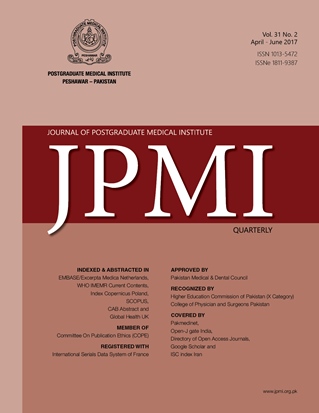COMPARATIVE INFLUENCE OF SUTURE MATERIALS AND RELATED RISK FACTORS ON THE INDUCTION OF SURGICAL SITE INFECTIONS IN SELECTED GYNECOLOGICAL PROCEDURES
Main Article Content
Abstract
Objective: To find out the comparative influence of various suture materials
and related risk factors in the development of post-operative surgical site infection.
Methodology: An observational analytical study was conducted retrospectively
in Gynae & Obstetric Units of Lady Reading Hospital, Hayatabad Medical
Complex & Khyber Teaching Hospital over a period of 4 months (1st February
2013 to 31st May 2013). Overall 45 patients with selected procedures, i.e. total
abdominal hysterectomy, lower segment caesarean section (LSCS), laparoscopy,
burch colposuspension & Fothergill repair using only specific suture materials
i.e. black silk, polypropylene, polyglactin 910 & chromic catgut, were
included in the study. The data was analysed using GraphPad Prism (GraphPad
Software Inc. San Diego CA, USA).
Results: Out of the total 45 cases, the procedure that resulted in most surgical
site infections was emergency lower segment caesarean section (LSCS)
followed by total abdominal hysterectomy. The suturing materials resulted in
the development of surgical site infection in an order of black silk ≥ polypropylene
≥ polyglactin 910. Among the identified pathogens, Staphylococcus ranked
higher than others. Resuturing of the wounds with similar material as initial
resulted in more pervasiveness of reinfection.
Conclusion: This study revealed that Black Silk results in most pathogenic surgical
site infections, followed by Polypropylene and Polyglactin 910.
and related risk factors in the development of post-operative surgical site infection.
Methodology: An observational analytical study was conducted retrospectively
in Gynae & Obstetric Units of Lady Reading Hospital, Hayatabad Medical
Complex & Khyber Teaching Hospital over a period of 4 months (1st February
2013 to 31st May 2013). Overall 45 patients with selected procedures, i.e. total
abdominal hysterectomy, lower segment caesarean section (LSCS), laparoscopy,
burch colposuspension & Fothergill repair using only specific suture materials
i.e. black silk, polypropylene, polyglactin 910 & chromic catgut, were
included in the study. The data was analysed using GraphPad Prism (GraphPad
Software Inc. San Diego CA, USA).
Results: Out of the total 45 cases, the procedure that resulted in most surgical
site infections was emergency lower segment caesarean section (LSCS)
followed by total abdominal hysterectomy. The suturing materials resulted in
the development of surgical site infection in an order of black silk ≥ polypropylene
≥ polyglactin 910. Among the identified pathogens, Staphylococcus ranked
higher than others. Resuturing of the wounds with similar material as initial
resulted in more pervasiveness of reinfection.
Conclusion: This study revealed that Black Silk results in most pathogenic surgical
site infections, followed by Polypropylene and Polyglactin 910.
Article Details
How to Cite
1.
Aqeel S, Samiullah ., Muhammad T, Shafqat T, Ahmad N, Raza A, et al. COMPARATIVE INFLUENCE OF SUTURE MATERIALS AND RELATED RISK FACTORS ON THE INDUCTION OF SURGICAL SITE INFECTIONS IN SELECTED GYNECOLOGICAL PROCEDURES. J Postgrad Med Inst [Internet]. 2017 May 12 [cited 2025 Dec. 5];31(2). Available from: https://jpmi.org.pk/index.php/jpmi/article/view/2045
Issue
Section
Original Article
Work published in JPMI is licensed under a
Creative Commons Attribution-NonCommercial 2.0 Generic License.
Authors are permitted and encouraged to post their work online (e.g., in institutional repositories or on their website) prior to and during the submission process, as it can lead to productive exchanges, as well as earlier and greater citation of published work.


